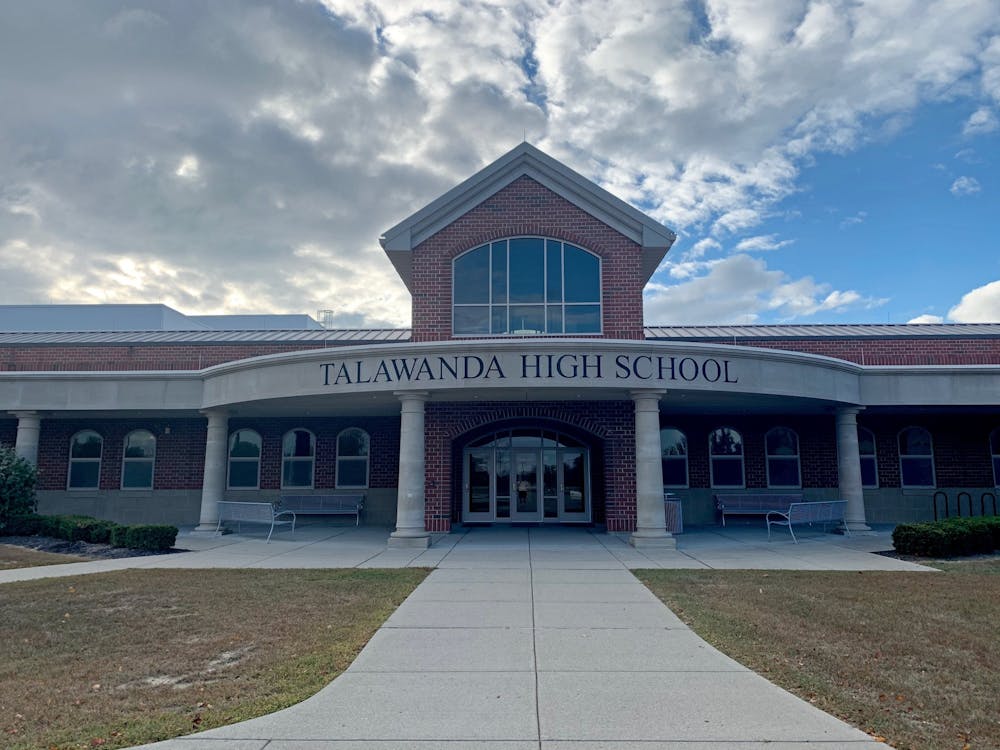Brianna Johnson has been a student in the Talawanda School District (TSD) since preschool. During that time, she has challenged herself academically through Advanced Placement (AP) classes, played a variety of sports like cheer and track and field and participated in many student organizations such as National Honor Society.
But over the next few years, Johnson and many other students will be stripped of their extracurriculars.
On Dec. 15, the Talawanda School Board members voted on a series of cuts, reductions and fees that will yield $5.3 million the next four school years after an operating levy failed to pass during the November midterm elections.
“Our leadership team looked at the services we currently had as well as the state minimum requirements,” Ed Theroux, superintendent for Talawanda School District wrote in an email to The Miami Student. “Using the state minimum requirements, our team identified many areas of revenue-generating as well as cuts/reductions."
The school district is made up of Bogan, Kramer and Marshall elementary schools, Talawanda Middle School and Talawanda High School (THS). To relieve the school district of its financial hardship, the school board voted on a plan that will tap into a dormant fund, which consists of money raised by alumni classes for student activities.
The school board is also instituting a “pay-to-play” fee for all high school and middle school sports and band students, as well as eliminating staff positions, removing art, music and physical education in the elementary schools, reducing area bussing, instituting fees for AP classes, cutting extracurricular activities and more.
“They’re choosing money over us actually growing and learning,” Johnson said.
Students worry about the future of the school district
As Johnson, a junior at THS, prepares for her senior year, she said the district has many opportunities for students beyond the classroom, but she’s worried it will not be the same due to the cuts.
“Talawanda, in past years, has been a really good school at giving you opportunities,” Johnson said. “But I feel like that will be taken away from the students, and they won’t be able to do specific things or challenge themselves or try a new sport.”
Nico Motta, a junior at THS, also sees many obstacles ahead for students.
Motta, who has been in the school district since kindergarten, plays on the football and lacrosse teams and sees the upcoming “pay-to-play” fee as a negative installment for students.
Enjoy what you're reading?
Signup for our newsletter
“You're kind of limiting a lot of student athletes, and then everyone has to make tough choices,” Motta said. “And that means you're pretty much limited to one sport as well.”

Many athletes like Motta are unsure what sports they will be able to participate in next school year.
“What if your parents can't afford it and you can't afford it, or you don't have a job?” Motta said. “That's really unfair.”
Faculty and staff feel the effects of the cuts
In addition to students, faculty and staff are also preparing for the cuts.
One of the positions impacted by the cuts will be school psychologists. The school district employs five psychologists, one at each school. According to the plan approved by the school board, two will be cut before the 2025-2026 school year, leaving the district with only three.
David Annable is the school psychologist at Kramer Elementary. Annable is the senior psychologist in the district, so his job is safe, but his colleagues’ jobs are in jeopardy.
“Because there’s five of us, there’s one of us per building, but if there’s only three of us, we're going to have to split up the work differently,” Annable said.
Annable works full-time at Kramer, so he is familiar with his students and knows their needs and services individually. After the cuts, though, he’ll need to spread his team out across five schools, which will make it harder to be fully knowledgeable on each student.
In addition to the decrease in psychologists, the number of social workers and counselors will also be reduced.
“It’s entirely possible there will be days in the elementary schools where there is no mental health staff,” Annable said.
While some faculty and staff are waiting to hear from the district about the status of their jobs, others are leaving the school district before the cuts.
On Jan. 6, Jay Volker, the head coach for the THS football team and student services worker, announced his resignation on Twitter due to the school district eliminating his teaching position next school year.
“My beliefs of the importance of athletics in the development of young men and women do not align with district beliefs,” the tweet said.
Volker did not respond to a request for comment from The Miami Student.
A call for reform outside the community
Holli Hansel, the communications director for the Talawanda School Board, believes the issue of funding public schools extends beyond the local community.
Public school districts in Ohio receive money through a combination of state funds, local property taxes and federal funds. The Ohio Department of Education (ODE) distributes aid using a formula based on student and teacher ratios, staffing levels and costs. ODE also provides supplemental funding based on student needs and demographics.
Hansel argues that the formula is not equitable for all school districts, including Talawanda.
Hansel said Talawanda struggles for funding because much of the land in the district is owned by Miami University, a tax-exempt institution. The school district is also surrounded by rural and agricultural communities, which makes it difficult to pass a property tax.
“Even though the total dollar amount for a farm is a lot of money, that farm may not actually be earning income at the level in which it is being taxed,” she said.
Hansel also acknowledged the surrounding communities have a lower median income, and a majority of residents in the district don’t have kids in the schools.
“When you think about the fact that most people living in the community do not have a child in one of our schools, they just don’t necessarily have a direct connection to the district, and they may feel less likely to support a tax issue that is a cost to them,” she said.
Will it be enough?
Despite the cuts, reductions and fees, Thereoux doubts the plan will solve long-term financial problems the district faces.
“Our plan will help extend the years before we are out of money,” he wrote. “We still will deficit spend and be out of money in approximately 2030. Additional difficult decisions will need to be made to avoid state takeover.”
Hansel said she can’t imagine what the district will look like if the state takes it over, but she worries that the students will be the most affected.
“We can’t expect our young people to be prepared for the modern world,” she said, “without the programs that [Talawanda] has in place and the amenities and resources.”




